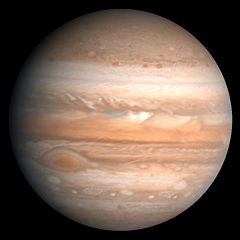Galilean moons
The Galilean moons are the four moons of Jupiter discovered by Galileo Galilei. They are the largest of the many moons of Jupiter and derive their names from the lovers of Zeus (the Greek equivalent of the Roman god Jupiter): Io, Europa, Ganymede and Callisto. Ganymede, Europa and Io participate in a 1:2:4 orbital resonance. They are among the most massive objects in the Solar System outside the Sun and the eight planets, with a radius larger than any of the dwarf planets.
The four moons were discovered sometime between 1609 and 1610 when Galileo made improvements to his telescope, which enabled him to observe celestial bodies more distinctly than had ever been possible before.[1] Galileo’s discovery showed the importance of the telescope as a tool for astronomers by proving that there were objects in space that cannot be seen by the naked eye. More importantly, the incontrovertible discovery of celestial bodies orbiting something other than the Earth dealt a serious blow to the then-accepted Ptolemaic world system, or the geocentric theory in which everything orbits around the Earth.
Galileo initially named his discovery the Cosmica Sidera ("Cosimo's stars"), but names that eventually prevailed were chosen by Simon Marius. Marius claimed to have discovered the moons at the same time as Galileo, and gave them their present names in his Mundus Jovialis, published in 1614.
Contents |
Historic
Discovery

As a result of improvements Galileo Galilei made to the telescope, with a magnifying capability of 30x,[2] he was able to see celestial bodies more distinctly than was ever possible before. This allowed Galilei to discover sometime between December 1609 and January 1610 what came to be known as the Galilean moons.[1] Nevertheless, a Chinese historian of astronomy, Xi Zezong, claimed that the Chinese astronomer Gan De observed one of Jupiter's moons in 362 BC, nearly 2 millennia earlier than Galileo.[3]
On January 7, 1610, Galileo wrote a letter containing the first mention of Jupiter’s moons. At the time, he saw only three of them, and he believed them to be fixed stars near Jupiter. He continued to observe these celestial orbs from January 8 to March 2, 1610. In these observations, he discovered a fourth body, and also observed that the four were not fixed stars, but rather were orbiting Jupiter.[1]
Galileo’s discovery proved the importance of the telescope as a tool for astronomers by showing that there were objects in space to be discovered that until then had remained unseen by the naked eye. More importantly, the incontrovertible discovery of celestial bodies orbiting something other than the Earth dealt a serious blow to the then-accepted Ptolemaic world system, which held that the Earth was at the center of the universe and all other celestial bodies revolved around it. That Jupiter has four moons while Earth has only one further undercut the near-universal belief that the Earth was the center of the universe both in position and in importance. Galileo's Sidereus Nuncius (Starry Messenger), which announced celestial observations through his telescope, does not explicitly mention Copernican heliocentrism, a theory that placed the Sun at the center of the universe. Nevertheless, Galileo believed in the Copernican theory.[1] As a result of these discoveries, Galileo was able to develop a method of determining longitude based on the timing of the orbits of the Galilean moons.
Dedication to the Medicis

In 1605, Galileo had been employed as a mathematics tutor for Cosimo de’ Medici. In 1609, Cosimo became Grand Duke Cosimo II of Tuscany. Galileo, seeking patronage from his now-wealthy former student and his powerful family, used the discovery of Jupiter’s moons to gain it.[1] On February 13, 1610, Galileo wrote to the Grand Duke’s secretary:
God graced me with being able, through such a singular sign, to reveal to my Lord my devotion and the desire I have that his glorious name live as equal among the stars, and since it is up to me, the first discoverer, to name these new planets, I wish, in imitation of the great sages who placed the most excellent heroes of that age among the stars, to inscribe these with the name of the Most Serene Grand Duke.[1]
Galileo asked whether he should name the moons the "Cosmian Stars," after Cosimo alone, or the "Medician Stars," which would honor all four brothers in the Medici clan. The secretary replied that the latter name would be best.[1]
On March 12, 1610, Galileo wrote his dedicatory letter to the Duke of Tuscany, and the next day sent a copy to the Grand Duke, hoping to obtain the Grand Duke’s support as quickly as possibly. On March 19, he sent the telescope he had used to first view Jupiter’s moons to the Grand Duke, along with an official copy of Sidereus Nuncius (The Starry Messenger) that, following the secretary's advice, named the four moons the Medician Stars.[1] In his dedicatory introduction, Galileo wrote:
[S]carcely have the immortal graces of your soul begun to shine forth on earth than bright stars offer themselves in the heavens which, like tongues, will speak of and celebrate your most excellent virtues for all time. Behold, therefore, four stars reserved for your illustrious name … which … make their journeys and orbits with a marvelous speed around the star of Jupiter … like children of the same family … Indeed, it appears the Maker of the Stars himself, by clear arguments, admonished me to call these new planets by the illustrious name of Your Highness before all others.[1]
Name
Galileo initially called his discovery the Cosmica Sidera ("Cosimo's stars"), in honour of Cosimo II de' Medici (1590–1621). At Cosmino's suggestion, Galileo changed the name to Medicea Sidera ("the Medician stars"), honouring all four Medici brothers (Cosimo, Francesco, Carlo, and Lorenzo). The discovery was announced in the Sidereus Nuncius ("Starry Messenger"), published in Venice in March 1610, less than two months after the first observations.
Other names put forward include:
- Principharus, Victipharus, Cosmipharus and Ferdinandipharus, for each of the four Medici brothers - by Giovanni Batista Hodierna, a disciple of Galileo and author of the first ephemerides (Medicaeorum Ephemerides, 1656);
- Circulatores Jovis, or Jovis Committees - by Johannes Hevelius;
- Gardes, or Satellites (from the Latin satelles, satellitis, meaning "escorts") - by Jacques Ozanam.
The names that eventually prevailed were chosen by Simon Marius, who claimed to have discovered the moons at the same time as Galileo: he named them after lovers of the god Zeus (the Greek equivalent of Jupiter): Io, Europa, Ganymede and Callisto, in his Mundus Jovialis, published in 1614.[4]
Galileo steadfastly refused to use Marius' names and invented as a result the numbering scheme that is still used nowadays, in parallel with proper moon names. The numbers run from Jupiter outward, thus I, II, III and IV for Io, Europa, Ganymede and Callisto respectively.[4] Galileo used this system in his notebooks but never actually published it. The numbered names (Jupiter x) were used until mid-20th century when other inner moons were discovered, and Marius' names became widely used.[4]
Members
The Galilean moons are, in increasing order of distance from Jupiter:
| Name |
Image | Diameter (km) |
Mass (kg) |
Density (g/cm³) |
Semi-major axis (km)[5] |
Orbital period(d) [6](relative) |
Inclination (°)[7] |
Eccentricity |
|---|---|---|---|---|---|---|---|---|
| Io (Jupiter I) |
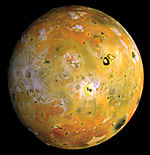 |
3660.0×3637.4×3630.6 | 8.93×1022 | 3.528 | 421,800 | 1.769 (1) |
0.050 | 0.0041 |
| Europa (Jupiter II) |
 |
3121.6 | 4.8×1022 | 3.014 | 671,100 | 3.551 (2) |
0.471 | 0.0094 |
| Ganymede (Jupiter III) |
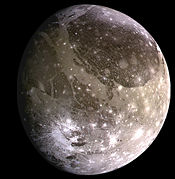 |
5262.4 | 1.48×1023 | 1.942 | 1,070,400 | 7.155 (4) |
0.204 | 0.0011 |
| Callisto (Jupiter IV) |
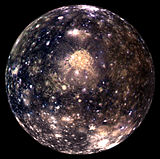 |
4820.6 | 1.08×1023 | 1.834 | 1,882,700 | 16.69 (9.4) |
0.205 | 0.0074 |
Io
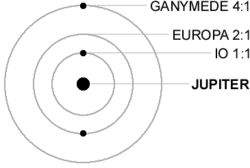
Io is the innermost of the four Galilean moons moons of Jupiter and, with a diameter of 3,642 kilometers, the fourth-largest moon in the Solar System. It was named after Io, a priestess of Hera who became one of the lovers of Zeus. Nevertheless, it was simply referred to as “Jupiter I,” or “The first satellite of Jupiter,” until mid-20th century.[4]
With over 400 active volcanoes, Io is the most geologically active object in the Solar System.[8] Its surface is dotted with more than 100 mountains some which are taller than Earth's Mount Everest.[9] Unlike most satellites in the outer Solar System (which have a thick coating of ice), Io is primarily composed of silicate rock surrounding a molten iron or iron sulfide core.
Although not proven, recent data from the Galileo orbiter indicates that Io might have its own magnetic field.[10] Io has an extremely thin atmosphere made up mostly of sulfur dioxide (SO2).[11] If a surface data or collection vessel were to land on Io in the future, it would have to be extremely tough (similar to the tank-like bodies of the Soviet Venera landers) to survive the radiation and magnetic fields that originate from Jupiter.[12]
Europa

Europa, the second of the four Galilean moons, is the second closest to Jupiter and the smallest at 3121.6 kilometers in diameter, which is slightly smaller than Earth's Moon. The name, Europa was after a mythical Phoenician noblewoman, Europa, who was courted by Zeus and became the queen of Crete, but did not become widely used until the mid-20th century.[4]
It is one of the smoothest object in the solar system,[13] with a layer of water surrounding the mantle of the planet, thought to be 100 kilometers thick.[14] The smooth surface includes a layer of ice, while the bottom of the ice is theorized to be liquid water.[15] The apparent youth and smoothness of the surface have led to the hypothesis that a water ocean exists beneath it, which could conceivably serve as an abode for extraterrestrial life.[16] Heat energy from tidal flexing ensures that the ocean remains liquid and drives geological activity.[17] Life may exist in Europa's under-ice ocean, perhaps subsisting in an environment similar to Earth's deep-ocean hydrothermal vents or the Antarctic Lake Vostok.[18] Life in such an ocean could possibly be similar to microbial life on Earth in the deep ocean.[19] So far, there is no evidence that life exists on Europa, but the likely presence of liquid water has spurred calls to send a probe there.[20]
The prominent markings that criss-cross the moon seem to be mainly albedo features, which emphasize low topography. There are few craters on Europa because its surface is tectonically active and young.[21] Some theories suggest that Jupiter’s gravity is causing these markings, as one side of Europa is constantly facing Jupiter. Also, volcanic water eruptions splitting the surface of Europa, and even geysers have been considered as a cause. The color of the markings, reddish-brown, is theorized to be caused by sulfur, but scientists cannot confirm that, because no data collection devices have been sent to Europa.[22] Europa is primarily made of silicate rock and likely has an iron core. It has a tenuous atmosphere composed primarily of oxygen.
Ganymede
Ganymede, the third Galilean is named the mythological Ganymede, cupbearer of the Greek gods and Zeus's beloved.[23] Ganymede is largest natural satellite in the Solar System at 5262.4 kilometers in diameter, which makes it larger than the planet Mercury - although only at about half of its mass.[24] It is the only satellite in the Solar System known to possess a magnetosphere, likely created through convection within the liquid iron core.[25]
Ganymede is composed primarily of silicate rock and water ice, and a salt-water ocean is believed to exist nearly 200 km below Ganymede's surface, sandwiched between layers of ice.[26] The metallic core of Ganymede suggests a greater heat at some time in its past than had previously been proposed. The surface is a mix of two types of terrain – highly cratered dark regions and younger, but still ancient, regions with a large array of grooves and ridges. Ganymede has a high number of craters, but many are gone or barely visible due to its icy crust forming over them. The satellite has a thin oxygen atmosphere that includes O, O2, and possibly O3 (ozone), and some atomic hydrogen.[27][28]
Callisto
Callisto is the fourth and last Galilean moon, and is the second largest of the four, and at 4820.6 kilometers in diameter, it is the third largest moon in the Solar System. It does not form part of the orbital resonance that affects three inner Galilean satellites and thus does not experience appreciable tidal heating.[29] Callisto is composed of approximately equal amounts of rock and ices, which makes it the least dense of the Galilean moons. It is one of the most heavily cratered satellites in the solar system, and one major feature is a basin around 3000 km wide called Valhalla.
Callisto is surrounded by an extremely thin atmosphere composed of carbon dioxide[30] and probably molecular oxygen.[31] Investigation revealed that Callisto may have possibly a subsurface ocean of liquid water at depths greater than 100 kilometers.[32] The likely presence of an ocean within Callisto indicates that it can or could harbor life. However, this is less likely than on nearby Europa.[33] Callisto has long been considered the most suitable place for a human base for future exploration of the system of Jupiter.[34]
Visibility

All four Galilean moons are bright enough that they could, if they were farther away from Jupiter, be sighted from Earth without a telescope. They have apparent magnitudes between 4.6 and 5.6 when Jupiter is in opposition with the Sun,[35] and are about one unit of magnitude dimmer when Jupiter is in conjunction. The main difficulty in observing the moons from Earth is their proximity to Jupiter since they are obscured by its brightness.[36] The maximum angular separations of the moons are between 2 and 10 minutes of arc from Jupiter,[37] close to the limit of human visual acuity. Ganymede and Callisto, at their maximum separation, are the likeliest targets for potential naked-eye observation. The easiest way to observe them is to cover Jupiter with an object, e.g. a tree limb or a power line that is perpendicular to the plane of moons' orbits.
References
- ↑ 1.0 1.1 1.2 1.3 1.4 1.5 1.6 1.7 1.8 Galilei, Galileo, Sidereus Nuncius. Translated and prefaced by Albert Van Helden. Chicago & London: University of Chicago Press 1989, 14–16
- ↑ Albert Van Helden (March 1974). "The Telescope in the Seventeenth Century". Isis (The University of Chicago Press on behalf of The History of Science Society) 65 (1): 38–58. doi:. http://www.jstor.org/stable/228880.
- ↑ Xi Zezong, "The Discovery of Jupiter's Satellite Made by Gan De 2000 years Before Galileo," Chinese Physics 2 (3) (1982): 664–67.
- ↑ 4.0 4.1 4.2 4.3 4.4 Marazzini, C. (2005). "The names of the satellites of Jupiter: from Galileo to Simon Marius". Lettere Italiana 57 (3): 391–407.
- ↑ Computed using the IAU-MPC Satellites Ephemeris Service µ value
- ↑ Source: JPL/NASA
- ↑ Computed from IAG Travaux 2001].
- ↑ Lopes, R. M. C.; et al. (2004). "Lava Lakes on Io: Observations of Io's Volcanic Activity from Galileo NIMS During the 2001 Fly-bys". Icarus 169 (1): 140–174. doi:. http://adsabs.harvard.edu/cgi-bin/nph-data_query?bibcode=2004Icar..169..140L&db_key=AST&link_type=ABSTRACT&high=45f9f8ee3003884.
- ↑ Schenk, P.; et al. (2001). "The Mountains of Io: Global and Geological Perspectives from Voyager and Galileo". Journal of Geophysical Research 106 (E12): 33201–33222. doi:. http://adsabs.harvard.edu/cgi-bin/nph-data_query?bibcode=2001JGR...10633201S&db_key=AST&link_type=ABSTRACT&high=45f9f8ee3004779.
- ↑ Porco, C. C.; et al. (2003). "Cassini imaging of Jupiter's atmosphere, satellites, and rings". Science 299: 1541–1547.
- ↑ McEwen, A. S.; et al. (1998). "High-temperature silicate volcanism on Jupiter's moon Io". Science 281: 87–90.
- ↑ Fanale, F. P.; et al. (1974). "Io: A Surface Evaporite Deposit?". Science 186 (4167): pp. 922–925. doi:. PMID 17730914. http://adsabs.harvard.edu/cgi-bin/nph-bib_query?bibcode=1974Sci...186..922F&db_key=AST&data_type=HTML&format=&high=45f9f8ee3017014.
- ↑ "Europa: Another Water World?". Project Galileo: Moons and Rings of Jupiter. NASA, Jet Propulsion Laboratory (2001). Retrieved on 2007-08-09.
- ↑ Schenk, P. M.; Chapman, C. R.; Zahnle, K.; Moore, J. M.; Chapter 18: Ages and Interiors: the Cratering Record of the Galilean Satellites, in Jupiter: The Planet, Satellites and Magnetosphere, Cambridge University Press, 2004
- ↑ Hamilton, C. J.. "Jupiter's Moon Europa".
- ↑ Tritt, Charles S. (2002). "Possibility of Life on Europa". Milwaukee School of Engineering. Retrieved on 2007-08-10.
- ↑ "Tidal Heating". geology.asu.edu. Retrieved on 2007-10-20.
- ↑ Exotic Microbes Discovered near Lake Vostok, Science@NASA (December 10, 1999)
- ↑ Jones, N.; Bacterial explanation for Europa's rosy glow, NewScientist.com (11 December 2001)
- ↑ Phillips, C.; Time for Europa, Space.com (28 September 2006)
- ↑ Arnett, B.; Europa (November 7, 1996)
- ↑ R.W. Carlson, M.S. Anderson (2005). "Distribution of hydrate on Europa: Further evidence for sulfuric acid hydrate". Retrieved on 2007-12-20.
- ↑ "Satellites of Jupiter". The Galileo Project. Retrieved on 2007-11-24.
- ↑ "Ganymede". nineplanets.org (October 31, 1997). Retrieved on 2008-02-27.
- ↑ Kivelson, M.G.; Khurana, K.K.; Coroniti, F.V. et.al. (2002). "The Permanent and Inductive Magnetic Moments of Ganymede" (pdf). Icarus 157: 507–522. doi:0.1006/icar.2002.6834 (inactive 2008-06-25). http://www.igpp.ucla.edu/people/mkivelson/Publications/ICRUS1572507.pdf.
- ↑ "Solar System's largest moon likely has a hidden ocean". Jet Propulsion Laboratory. NASA (2000-12-16). Retrieved on 2008-01-11.
- ↑ Hall, D.T.; Feldman, P.D.; McGrath, M.A. et.al. (1998). "The Far-Ultraviolet Oxygen Airglow of Europa and Ganymede". The Astrophysical Journal 499: 475–481. doi:. http://adsabs.harvard.edu/abs/1998ApJ...499..475H.
- ↑ Eviatar, Aharon; Vasyliunas, Vytenis M.; Gurnett, Donald A. et.al. (2001). "The ionosphere of Ganymede" (ps). Plan.Space Sci. 49: 327–336. doi:. http://www.tau.ac.il/~arkee/ganymop.ps.
- ↑ Musotto, Susanna; Varadi, Ferenc; Moore, William; Schubert, Gerald (2002). "Numerical Simulations of the Orbits of the Galilean Satellites". Icarus 159: 500–504. doi:. http://adsabs.harvard.edu/abs/2002Icar..159..500M.
- ↑ Carlson, R. W.; et al. (1999). "A Tenuous Carbon Dioxide Atmosphere on Jupiter's Moon Callisto" (pdf). Science 283: 820–821. doi:. PMID 9933159. http://trs-new.jpl.nasa.gov/dspace/bitstream/2014/16785/1/99-0186.pdf.
- ↑ Liang, M. C.; Lane, B. F.; Pappalardo, R. T.; et al. (2005). "Atmosphere of Callisto" (pdf). Journal of Geophysics Research 110: E02003. doi:. http://yly-mac.gps.caltech.edu/ReprintsYLY/N164Liang_Callisto%2005/Liang_callisto_05.pdf.
- ↑ Showman, Adam P.; Malhotra, Renu (1999). "The Galilean Satellites" (pdf). Science 286: 77–84. doi:. PMID 10506564. http://www.lpl.arizona.edu/~showman/publications/showman-malhotra-1999.pdf.
- ↑ Lipps, Jere H.; Delory, Gregory; Pitman, Joe; et.al. (2004). "Astrobiology of Jupiter’s Icy Moons" (pdf). Proc. SPIE 5555: 10. doi:. http://learning.berkeley.edu/astrobiology/2004ppt/jupiter.pdf.
- ↑ Trautman, Pat; Bethke, Kristen (2003). "Revolutionary Concepts for Human Outer Planet Exploration(HOPE)" (pdf). NASA.
- ↑ Yeomans, Donald K. (2006-07-13). "Planetary Satellite Physical Parameters". JPL Solar System Dynamics. Retrieved on 2008-08-23.
- ↑ Jupiter is about 750 times brighter than Ganymede and about 2000 times brighter than Callisto.
Ganymede: (5th root of 100)^(4.4 Ganymede APmag - (-2.8 Jup APmag)) = 758
Callisto: (5th root of 100)^(5.5 Callisto APmag - (-2.8 Jup APmag)) = 2089 - ↑ Jupiter near perihelion 2010-Sep-19: 656.7 (Callisto angular separation arcsec) - 24.9 (jup angular radius arcsec) = 631 arcsec = 10 arcmin
See also
- Jupiter's natural satellites
- Jupiter's moons in fiction
External links
|
||||||||||||||||||||||||||||||||||||||||
|
|||||||||||||||||
|
||||||||||||||||
|
|||||||||||||||||


